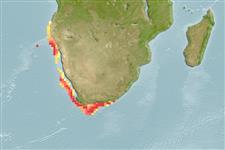Ελασμοβράγχιοι (καρχαρίες και σαλάχια) (sharks and rays) >
Rajiformes (Skates and rays) >
Gurgesiellidae (Pygmy skates)
Etymology: Cruriraja: Latin, crur, cruris = pertaining to a leg + Latin, raja = a ray (Raja sp) (Ref. 45335); hulleyi: Named for P.A. ‘‘Butch’’ Hulley, for his pioneering research on southern African skates.
Eponymy: Dr Percy Alexander ‘Butch’ Hulley (d: 1941) is a South African zoologist and ichthyologist. [...] (Ref. 128868), visit book page.
Environment: milieu / climate zone / depth range / distribution range
Οικολογία
Θαλασσινό(ά) βενθοπελαγικό; εύρος βάθους 39 - 545 m (Ref. 85323), usually 200 - 500 m (Ref. 85323). Subtropical
Southeast Atlantic: Lüderitz, Namibia to Algoa (and possibly East London) on the Eastern Cape coast of South Africa.
Μέγεθος / Βάρος / Age
Maturity: Lm ? range ? - ? cm
Max length : 58.0 cm TL αρσενικό/απροσδιόριστο; (Ref. 85323); 59.4 cm TL (female)
Short description
Κλείδες προσδιορισμού | Μορφολογία | Μορφομετρία
This species is distinct from its congeners in having the following characters: spatulate distal ends of the anterior pelvic lobes (wider tip in C. cadenati, tapering in others); dorsal mid-disk and tail with continuous semiparallel rows of thorns in adults (no thorns on mid-disk in C. rugosa, present on midline in others); claspers with small, flattened process (boss) on accessory terminal 2 cartilage and blind-ended sac with posterior opening at the distal end of the clasper (sentina), both unique within genus to C. hulleyi; interdorsal thorns 6 (none in C. durbanensis, 2 in C. parcomaculata, 4 in C. poeyi, 1 in C. rugosa, many in C. atlantis). This species is further distinguished from its congeners by the following set of characters: interdorsal distance greater than half, and not exceeding, dorsal-fin base length (vs. at least 1.5 times dorsal-fin base length in C. atlantis, half or less dorsal-fin base length in C. parcomaculata); outer lateral margin of clasper dorsal marginal cartilage elongated and bluntly rounded (truncate in C. rugosa); proximal margin of dorsal terminal I cartilage forms a point (a series of points in C. rugosa); distal point (eperon) of ventral terminal cartilage relatively narrow and claw-like (bifurcate in C. parcomaculata, expanded in C. rugosa); ventral surface of clasper without dermal denticles (present in C. parcomaculata) (Ref. .85323).
Reported to be a moderately common species of the outer shelf and upper continental slope, 39-545 m deep, but most common between 200 and 500 depth. Larger individuals tend to occur on the west coast of southern Africa, while those on the south coast are slightly smaller. The egg case was described to be small, vase-like, measuring less than 50 mm long excluding horns, surface coarsely striated, and with very narrow lateral keels, <1% of maximum egg case width; its posterior horns are approximately 45% longer than the anterior horns, tapering to thin tips, curving inwards and with fine attachment fibers; the anterior horns are hook-shaped, with acute tips (Ref. 85323).
Life cycle and mating behavior
Γεννητική Ωρίμανση | Αναπαραγωγή | Γεννοβολία | Αβγά | Γονιμότητα | Προνύμφες
Aschliman, N.C., D.A. Ebert and L.J.V. Compagno, 2010. A new legskate (Rajoidei: Genus Cruriraja) from Southern Africa. Copeia 2010(3):364-372. (Ref. 85323)
IUCN Red List Status (Ref. 130435: Version 2024-1)
Threat to humans
Harmless
Human uses
Εργαλεία
Special reports
Download XML
Διαδικτυακές πηγές
Estimates based on models
Preferred temperature (Ref.
123201): 6.7 - 14, mean 9.5 °C (based on 54 cells).
Phylogenetic diversity index (Ref.
82804): PD
50 = 0.5039 [Uniqueness, from 0.5 = low to 2.0 = high].
Bayesian length-weight: a=0.00661 (0.00222 - 0.01969), b=2.95 (2.71 - 3.19), in cm total length, based on LWR estimates for this (Sub)family-body shape (Ref.
93245).
Τροφικό Επίπεδο (Ref.
69278): 3.9 ±0.6 se; based on size and trophs of closest relatives
Fishing Vulnerability (Ref.
59153): Moderate vulnerability (44 of 100).
